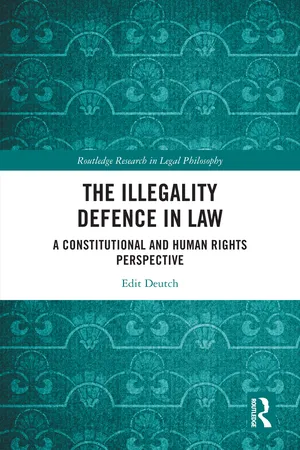
- English
- ePUB (mobile friendly)
- Available on iOS & Android
About this book
The Illegality Defence posits that a cause of action cannot arise from a wrongful act. Barring a claim through the application of this defence contradicts considerations of corrective justice, as the defendant is released from liability even though the claimant would otherwise have been entitled to a remedy. This book re-examines the application of the Illegality Defence, framing it as a State deprivation of property for the public good, underscoring the necessity of constitutional protections in this context. Offering a novel approach, the work explores the development, interpretation, and application of the Illegality Defence within a constitutional framework, bridging the gap between private and public law. By delving into the structured concepts of proportionality, it aims to establish a more refined legal model which is sensitive to the protection of human rights – specifically, the human right to property. This approach seeks to enhance legal certainty and predictability in the application of the Illegality Defence. The study will be essential reading for academics and researchers working in the areas of legal theory, human rights law, and jurisprudence.
Frequently asked questions
- Essential is ideal for learners and professionals who enjoy exploring a wide range of subjects. Access the Essential Library with 800,000+ trusted titles and best-sellers across business, personal growth, and the humanities. Includes unlimited reading time and Standard Read Aloud voice.
- Complete: Perfect for advanced learners and researchers needing full, unrestricted access. Unlock 1.4M+ books across hundreds of subjects, including academic and specialized titles. The Complete Plan also includes advanced features like Premium Read Aloud and Research Assistant.
Please note we cannot support devices running on iOS 13 and Android 7 or earlier. Learn more about using the app.
Information
Table of contents
- Cover
- Half-Title
- Series
- Title
- Copyright
- Dedication
- Contents
- Preamble
- Introduction and Outline
- PART A
- The Rationales for the Illegality Principle
- PART B
- The Constitutional-Based Model of the Illegality Principle
- PART C
- The Doctrinal Components of Illegality in Light of the Constitutional Model
- PART D
- Implementation and Conclusion
- Conclusion
- Bibliography
- Index